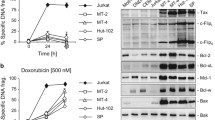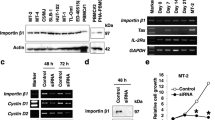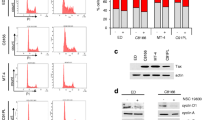Abstract
HIV-1 viral protein R (Vpr) can induce cell cycle arrest and cell death, and may be beneficial in cancer therapy to suppress malignantly proliferative cell types, such as adult T-cell leukemia (ATL) cells. In this study, we examined the feasibility of employing the HIV-vpr gene, via targeted gene transfer, as a potential new therapy to kill ATL cells. We infected C8166 cells with a recombinant adenovirus carrying both vpr and GFP genes (rAd-vpr), as well as the vector control virus (rAd-vector). G2/M phase cell cycle arrest was observed in the rAd-vpr infected cells. Typical characteristics of apoptosis were detected in rAd-vpr infected cells, including sub-diploid peak exhibition in DNA content assay, the Hoechst 33342 accumulation, apoptotic body formation, mitochondrial membrane potential and plasma membrane integrity loss. The proteomic assay revealed apoptosis related protein changes, exhibiting the regulation of caspase-3 activity indicator proteins (vimentin and Rho GDP-dissociation inhibitor 2), mitochondrial protein (prohibitin) and other regulatory proteins. In addition, the up-regulation of anti-inflammatory redox protein, thioredoxin, was identified in the rAd-vpr infected group. Further supporting these findings, the increase of caspase 3&7 activity in the rAd-vpr infected group was observed. In conclusion, endogenous Vpr is able to kill HTLV-1 transformed C8166 cells, and may avoid the risks of inducing severe inflammatory responses through apoptosis-inducing and anti-inflammatory activities.





Similar content being viewed by others
Abbreviations
- HTLV-1:
-
Human T-cell leukemia virus-1
- MFI:
-
Mean fluorescence intensity
- Pfu:
-
Plaque-forming unit
- Vpr:
-
Viral protein R
- 2DE:
-
Two-dimensional electrophoresis
References
Lilienbaum A, Paulin D (1993) Activation of the human vimentin gene by the Tax human T-cell leukemia virus. I. Mechanisms of regulation by the NF-kappa B transcription factor. J Biol Chem 268:2180–2188
Miyake K, Inokuchi K, Miyake N, Dan K, Shimada T (2007) HIV vector-mediated targeted suicide gene therapy for adult T-cell leukemia. Gene Ther 14:1662–1667. doi:10.1038/sj.gt.3303024
Tsukasaki K, Tanosaki S, DeVos S et al (2004) Identifying progression-associated genes in adult T-cell leukemia/lymphoma by using oligonucleotide microarrays. Int J Cancer 109:875–881. doi:10.1002/ijc.20028
Kami M, Hamaki T, Miyakoshi S et al (2003) Allogeneic haematopoietic stem cell transplantation for the treatment of adult T-cell leukaemia/lymphoma. Br J Haematol 120:304–309
Michelfelder S, Lee MK, DeLima-Hahn E et al (2007) Vectors selected from adeno-associated viral display peptide libraries for leukemia cell-targeted cytotoxic gene therapy. Exp Hematol 35:1766–1776. doi:10.1016/j.exphem.2007.07.018
Alimonti JB, Ball TB, Fowke KR (2003) Mechanisms of CD4+ T lymphocyte cell death in human immunodeficiency virus infection and AIDS. J Gen Virol 84:1649–1661
Borgne-Sanchez A, Dupont S, Langonne A et al (2007) Targeted Vpr-derived peptides reach mitochondria to induce apoptosis of alphaVbeta3-expressing endothelial cells. Cell Death Differ 14:422–435. doi:10.1038/sj.cdd.4402018
Patel CA, Mukhtar M, Pomerantz RJ (2000) Human immunodeficiency virus type 1 Vpr induces apoptosis in human neuronal cells. J Virol 74:9717–9726
Andersen JL, Planelles V (2005) The role of Vpr in HIV-1 pathogenesis. Curr HIV Res 3:43–51
Tungaturthi PK, Sawaya BE, Singh SP et al (2003) Role of HIV-1 Vpr in AIDS pathogenesis: relevance and implications of intravirion, intracellular and free Vpr. Biomed Pharmacother 57:20–24. doi:10.1016/S0753-3322(02)00328-1
Li L, Li HS, Pauza CD, Bukrinsky M, Zhao RY (2005) Roles of HIV-1 auxiliary proteins in viral pathogenesis and host-pathogen interactions. Cell Res 15:923–934. doi:10.1038/sj.cr.7290370
Toborek M, Lee YW, Flora G et al (2005) Mechanisms of the blood-brain barrier disruption in HIV-1 infection. Cell Mol Neurobiol 25:181–199
Jones GJ, Barsby NL, Cohen EA et al (2007) HIV-1 Vpr causes neuronal apoptosis and in vivo neurodegeneration. J Neurosci 27:3703–3711. doi:10.1523/JNEUROSCI.5522-06.2007
Mahalingam S, MacDonald B, Ugen KE et al (1997) In vitro and in vivo tumor growth suppression by HIV-1 Vpr. DNA Cell Biol 16:137–143
Muthumani K, Choo AY, Hwang DS, Ugen KE, Weiner DB (2004) HIV-1 Vpr: enhancing sensitivity of tumors to apoptosis. Curr Drug Deliv 1:335–344
Elder RT, Benko Z, Zhao Y (2002) HIV-1 VPR modulates cell cycle G2/M transition through an alternative cellular mechanism other than the classic mitotic checkpoints. Front Biosci 7:d349–d357
Blazquez MV, Macho A, Ortiz C et al (1999) Extracellular HIV type 1 Tat protein induces CD69 expression through NF-kappaB activation: possible correlation with cell surface Tat-binding proteins. AIDS Res Hum Retroviruses 15:1209–1218
Boirivant M, Viora M, Giordani L et al (1998) HIV-1 gp120 accelerates Fas-mediated activation-induced human lamina propria T cell apoptosis. J Clin Immunol 18:39–47
Goh WC, Rogel ME, Kinsey CM et al (1998) HIV-1 Vpr increases viral expression by manipulation of the cell cycle: a mechanism for selection of Vpr in vivo. Nat Med 4:65–71
Bolton DL, Lenardo MJ (2007) Vpr cytopathicity independent of G2/M cell cycle arrest in human immunodeficiency virus type 1-infected CD4+ T cells. J Virol 81:8878–8890. doi:10.1128/JVI.00122-07
Chowdhury IH, Wang XF, Landau NR et al (2003) HIV-1 Vpr activates cell cycle inhibitor p21/Waf1/Cip1: a potential mechanism of G2/M cell cycle arrest. Virology 305:371–377. doi:10.1006/viro.2002.1777
Ayyavoo V, Mahalingam S, Rafaeli Y et al (1997) HIV-1 viral protein R (Vpr) regulates viral replication and cellular proliferation in T cells and monocytoid cells in vitro. J Leukoc Biol 62:93–99
Wang J, Hasui K, Utsunomiya A, Jia X, Matsuyama T, Murata F (2008) Association of high proliferation in adult T-cell leukemia cells with apoptosis, and expression of p53 protein in acute type ATL. J Clin Exp Hematop 48:1–10. doi:10.3960/jslrt.48.1
Takemoto S, Mulloy JC, Cereseto A et al (1997) Proliferation of adult T cell leukemia/lymphoma cells is associated with the constitutive activation of JAK/STAT proteins. Proc Natl Acad Sci USA 94:13897–13902
He TC, Zhou S, da Costa LT, Yu J, Kinzler KW, Vogelstein B (1998) A simplified system for generating recombinant adenoviruses. Proc Natl Acad Sci USA 95:2509–2514
Wang T, Gong N, Liu J et al (2008) HIV-1-infected astrocytes and the microglial proteome. J Neuroimmune Pharmacol 3:173–186. doi:10.1007/s11481-008-9110-x
Wang T, Gong N, Liu J et al (2008) Proteomic modeling for HIV-1 infected microglia-astrocyte crosstalk. PLoS ONE 3:e2507. doi:10.1371/journal.pone.0002507
Hu S, Xie Y, Ramachandran P et al (2005) Large-scale identification of proteins in human salivary proteome by liquid chromatography/mass spectrometry and two-dimensional gel electrophoresis-mass spectrometry. Proteomics 5:1714–1728. doi:10.1002/pmic.200401037
Paul R, Haydon RC, Cheng H et al (2003) Potential use of Sox9 gene therapy for intervertebral degenerative disc disease. Spine 28:755–763
Hu ZB, Wu CT, Wang H et al (2008) A simplified system for generating oncolytic adenovirus vector carrying one or two transgenes. Cancer Gene Ther 15:173–182. doi:10.1038/sj.cgt.7701105
Cossarizza A, Baccarani-Contri M, Kalashnikova G, Franceschi C (1993) A new method for the cytofluorimetric analysis of mitochondrial membrane potential using the J-aggregate forming lipophilic cation 5,5′,6,6′-tetrachloro-1,1′,3,3′-tetraethylbenzimidazolcarbocyanine iodide (JC-1). Biochem Biophys Res Commun 197:40–45. doi:10.1006/bbrc.1993.2438
Smiley ST, Reers M, Mottola-Hartshorn C et al (1991) Intracellular heterogeneity in mitochondrial membrane potentials revealed by a J-aggregate-forming lipophilic cation JC-1. Proc Natl Acad Sci USA 88:3671–3675
Reynolds JE, Li J, Eastman A (1996) Detection of apoptosis by flow cytometry of cells simultaneously stained for intracellular pH (carboxy SNARF-1) and membrane permeability (Hoechst 33342). Cytometry 25:349–357
El-Aneed A (2004) An overview of current delivery systems in cancer gene therapy. J Control Release 94:1–14. doi:10.1016/j.jconrel.2003.09.013
Goncalves MA, de Vries AA (2006) Adenovirus: from foe to friend. Rev Med Virol 16:167–186. doi:10.1002/rmv.494
Zhang Y, Ma H, Zhang J, Liu S, Liu Y, Zheng D (2008) AAV-mediated TRAIL gene expression driven by hTERT promoter suppressed human hepatocellular carcinoma growth in mice. Life Sci 82:1154–1161. doi:10.1016/j.lfs.2008.03.023
Suh W, Chung JK, Park SH, Kim SW (2001) Anti-JL1 antibody-conjugated poly (l-lysine) for targeted gene delivery to leukemia T cells. J Control Release 72:171–178. doi:10.1016/S0168-3659(01)00273-5
Zhao X, Li H, Lee RJ (2008) Targeted drug delivery via folate receptors. Expert Opin Drug Deliv 5:309–319. doi:10.1517/17425247.5.3.309
Metzl C, Mischek D, Salmons B, Gunzburg WH, Renner M, Portsmouth D (2006) Tissue- and tumor-specific targeting of murine leukemia virus-based replication-competent retroviral vectors. J Virol 80:7070–7078. doi:10.1128/JVI.00020-06
Blumenthal M, Skelton D, Pepper KA, Jahn T, Methangkool E, Kohn DB (2007) Effective suicide gene therapy for leukemia in a model of insertional oncogenesis in mice. Mol Ther 15:183–192. doi:10.1038/sj.mt.6300015
Staal FJ, Pike-Overzet K, Ng YY, van Dongen JJ (2008) Sola dosis facit venenum. Leukemia in gene therapy trials: a question of vectors, inserts and dosage? Leukemia 22:1849–1852. doi:10.1038/leu.2008.219
Choi J, Walker J, Talbert-Slagle K, Wright P, Pober JS, Alexander L (2005) Endothelial cells promote human immunodeficiency virus replication in nondividing memory T cells via Nef-, Vpr-, and T-cell receptor-dependent activation of NFAT. J Virol 79:11194–11204. doi:10.1128/JVI.79.17.11194-11204.2005
Cheng X, Mukhtar M, Acheampong EA et al (2007) HIV-1 Vpr potently induces programmed cell death in the CNS in vivo. DNA Cell Biol 26:116–131. doi:10.1089/dna.2006.0541
Wheeler ED, Achim CL, Ayyavoo V (2006) Immunodetection of human immunodeficiency virus type 1 (HIV-1) Vpr in brain tissue of HIV-1 encephalitic patients. J Neurovirol 12:200–210. doi:10.1080/13550280600827377
Azuma A, Matsuo A, Suzuki T, Kurosawa T, Zhang X, Aida Y (2006) Human immunodeficiency virus type 1 Vpr induces cell cycle arrest at the G(1) phase and apoptosis via disruption of mitochondrial function in rodent cells. Microbes Infect 8:670–679
Planelles V, Jowett JB, Li QX, Xie Y, Hahn B, Chen IS (1996) Vpr-induced cell cycle arrest is conserved among primate lentiviruses. J Virol 70:2516–2524
Bolton DL, Barnitz RA, Sakai K, Lenardo MJ (2008) 14-3-3 theta binding to cell cycle regulatory factors is enhanced by HIV-1 Vpr. Biol Direct 3:17. doi:10.1186/1745-6150-3-17
Wang Z, Yu BW, Rahman KM, Ahmad F, Sarkar FH (2008) Induction of growth arrest and apoptosis in human breast cancer cells by 3,3-diindolylmethane is associated with induction and nuclear localization of p27kip. Mol Cancer Ther 7:341–349. doi:10.1158/1535-7163.MCT-07-0476
Chang JH, Kwon HY (2007) Expression of 14-3-3delta, cdc2 and cyclin B proteins related to exotoxin A-induced apoptosis in HeLa S3 cells. Int Immunopharmacol 7:1185–1191. doi:10.1016/j.intimp.2007.05.001
Chen JS, Lin SY, Tso WL et al (2006) Checkpoint kinase 1-mediated phosphorylation of Cdc25C and bad proteins are involved in antitumor effects of loratadine-induced G2/M phase cell-cycle arrest and apoptosis. Mol Carcinog 45:461–478. doi:10.1002/mc.20165
Gate L, Lunk A, Tew KD (2003) Resistance to phorbol 12-myristate 13-acetate-induced cell growth arrest in an HL60 cell line chronically exposed to a glutathione S-transferase pi inhibitor. Biochem Pharmacol 65:1611–1622. doi:10.1016/S0006-2952(03)00152-7
Fischer C, Sanchez-Ruderisch H, Welzel M et al (2005) Galectin-1 interacts with the {alpha}5{beta}1 fibronectin receptor to restrict carcinoma cell growth via induction of p21 and p27. J Biol Chem 280:37266–37277. doi:10.1074/jbc.M411580200
Marshall JC, Watson RW (1997) Programmed cell death (apoptosis) and the resolution of systemic inflammation. Can J Surg 40:169–174
Williams GT (1991) Programmed cell death: apoptosis and oncogenesis. Cell 65:1097–1098. doi:10.1016/0092-8674(91)90002-G
Green DR, Reed JC (1998) Mitochondria and apoptosis. Science 281:1309–1312
Szabadkai G, Duchen MR (2008) Mitochondria: the hub of cellular Ca2+ signaling. Physiology (Bethesda) 23:84–94. doi:10.1152/physiol.00046.2007
Kroemer G, Dallaporta B, Resche-Rigon M (1998) The mitochondrial death/life regulator in apoptosis and necrosis. Annu Rev Physiol 60:619–642. doi:10.1146/annurev.physiol.60.1.619
Zhang MH, Lee JS, Kim HJ et al (2006) HSP90 protects apoptotic cleavage of vimentin in geldanamycin-induced apoptosis. Mol Cell Biochem 281:111–121. doi:10.1007/s11010-006-0638-x
Krieser RJ, Eastman A (1999) Cleavage and nuclear translocation of the caspase 3 substrate Rho GDP-dissociation inhibitor, D4-GDI, during apoptosis. Cell Death Differ 6:412–419. doi:10.1038/sj.cdd.4400515
Choi MR, Groot M, Drexler HC (2007) Functional implications of caspase-mediated RhoGDI2 processing during apoptosis of HL60 and K562 leukemia cells. Apoptosis 12:2025–2035. doi:10.1007/s10495-007-0121-5
Ikonen E, Fiedler K, Parton RG, Simons K (1995) Prohibitin, an antiproliferative protein, is localized to mitochondria. FEBS Lett 358:273–277. doi:10.1016/0014-5793(94)01444-6
Fassl S, Leisser C, Huettenbrenner S et al (2003) Transferrin ensures survival of ovarian carcinoma cells when apoptosis is induced by TNFalpha, FasL, TRAIL, or Myc. Oncogene 22:8343–8355. doi:10.1038/sj.onc.1207047
Lanteri M, Giordanengo V, Hiraoka N et al (2003) Altered T cell surface glycosylation in HIV-1 infection results in increased susceptibility to galectin-1-induced cell death. Glycobiology 13:909–918
De Santis ML, Hammamieh R, Das R, Jett M (2004) Adipocyte-fatty acid binding protein induces apoptosis in DU145 prostate cancer cells. J Exp Ther Oncol 4:91–100
Vavrova J, Janovska S, Rezacova M et al (2007) Proteomic analysis of MOLT-4 cells treated by valproic acid. Mol Cell Biochem 303:53–61. doi:10.1007/s11010-007-9455-0
Iguchi T, Yachide-Noguchi T, Hashimoto Y et al (2008) Novel tubulin-polymerization inhibitor derived from thalidomide directly induces apoptosis in human multiple myeloma cells: possible anti-myeloma mechanism of thalidomide. Int J Mol Med 21:163–168
Muthumani K, Desai BM, Hwang DS et al (2004) HIV-1 Vpr and anti-inflammatory activity. DNA Cell Biol 23:239–247. doi:10.1089/104454904773819824
Lemarechal H, Anract P, Beaudeux JL, Bonnefont-Rousselot D, Ekindjian OG, Borderie D (2007) Expression and extracellular release of Trx80, the truncated form of thioredoxin, by TNF-alpha- and IL-1beta-stimulated human synoviocytes from patients with rheumatoid arthritis. Clin Sci 113:149–155. doi:10.1042/CS20070067
Xiao Y, Chen G, Richard J et al (2008) Cell-surface processing of extracellular human immunodeficiency virus type 1 Vpr by proprotein convertases. Virology 372:384–397. doi:10.1016/j.virol.2007.10.036
Iordanskiy S, Zhao Y, Dubrovsky L et al (2004) Heat shock protein 70 protects cells from cell cycle arrest and apoptosis induced by human immunodeficiency virus type 1 viral protein R. J Virol 78:9697–9704. doi:10.1128/JVI.78.18.9697-9704.2004
Acknowledgments
The authors would like to thank Hailan Tang, Xinqiang Lai, Core Facility of Experimental Technology, Jinan University, for their great technical assistance in laser confocal and flow cytometry; Xin Zhang, Bing Song and Xiaoyu Lu, Jninan University, for fluorescence microscopy, and other technical supports. We thank Gregory Dann, Jazel Dolores and Charlotte Pan, University of Washington School of Medicine, for their critical reading of this article. This study is a part of the thesis of Fang He, supervised by both Drs. Yaoying Zeng and Tong Wang, submitted in fulfillment of the requirements for the degree of Doctor of Medicine at the Jinan University, Guangzhou, China. This work was supported by the Natural Science Foundation of Guangdong Province, China (Grant No. 5300413, T.W.), New Investigator Award, USA (UW/FHCRC CFAR AI 27757, T.W.), the Major State Basic Research Program (973), China (Grant No. 2006CB504200, Y.Z.), and the Key Subject of Biochemistry and Molecular Biology of Guangdong Province, China (T.W. and X.H.).
Author information
Authors and Affiliations
Corresponding authors
Rights and permissions
About this article
Cite this article
He, F., Zeng, Y., Wu, X. et al. Endogenous HIV-1 Vpr-mediated apoptosis and proteome alteration of human T-cell leukemia virus-1 transformed C8166 cells. Apoptosis 14, 1212–1226 (2009). https://doi.org/10.1007/s10495-009-0380-4
Published:
Issue Date:
DOI: https://doi.org/10.1007/s10495-009-0380-4




